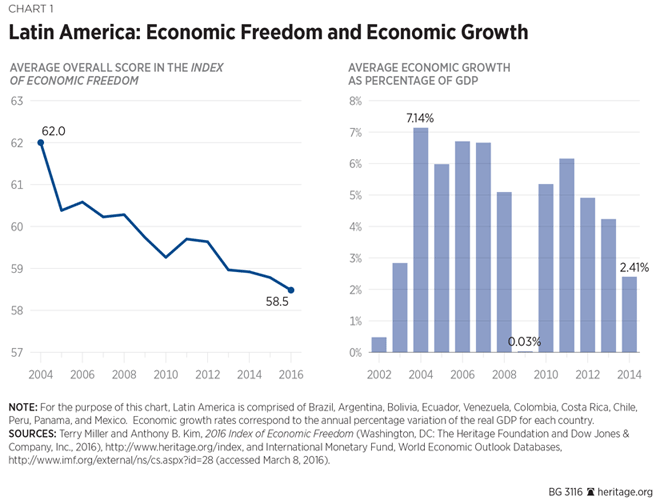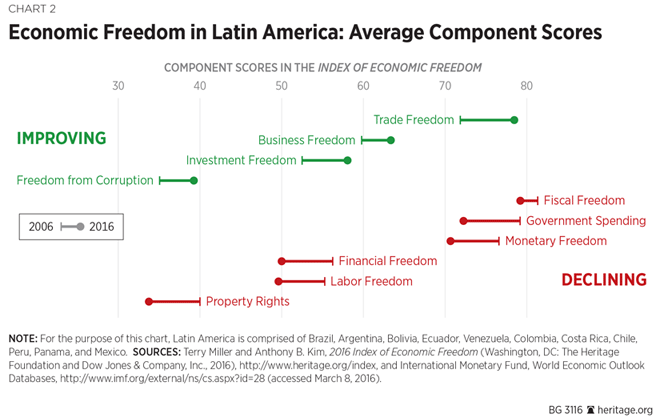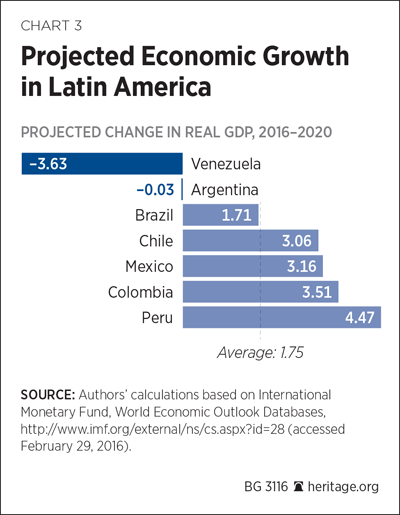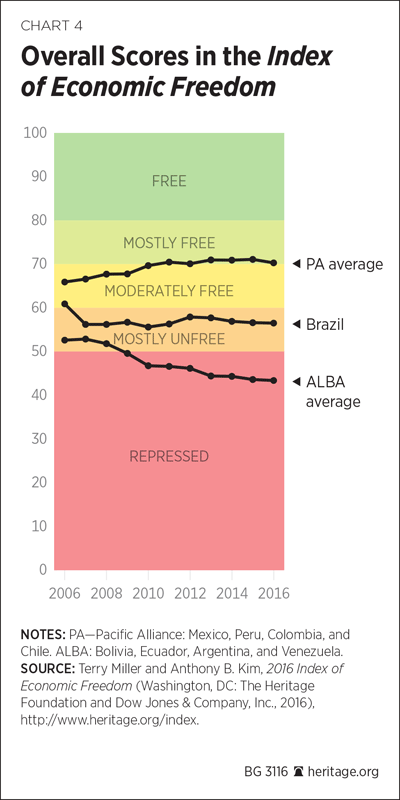James Roberts
Research Fellow For Economic Freedom and Growth
James M. Roberts' primary responsibility is to edit the Rule of
Law and Monetary Freedom sections of Index of Economic Freedom.
Unfortunately, little was done during the good years to implement difficult—but necessary—structural reforms to remove the real obstacles in Latin America that have limited productivity growth and thwarted convergence with more advanced economies. In fact, economic freedom—as measured by the annual Heritage Foundation Index of Economic Freedom—declined in the region as a whole.
This Backgrounder examines those reform failures, makes a strong case that economic freedom matters for sustainable prosperity, and analyzes the connection between growth and the core policy principles of the Index. It also analyzes Latin American countries grouped in the region’s three blocs (the ALBA[3] countries plus Argentina, the Pacific Alliance, and Brazil) and examines their weaknesses and strengths as measured by the Index.
Based on that analysis, a road map of practical reforms for those countries or blocs is identified to overcome structural weaknesses, achieve high sustainable growth, and make lasting social improvements. With greater economic freedom, the region will no longer need to depend merely on good luck—but on the solid economic fundamentals that combine to produce free and prosperous societies.
Latin America’s Failure to Converge
Between 2004 and 2013—excluding 2009, the worst year of the financial crisis—the seven largest economies in Latin America (LAC-7)[4] grew at an average rate of 5.6 percent annually, which was substantially above the historical average of 3.7 percent since the early 1990s,[5] creating the impression that Latin America had embarked on the path to a new era of development. In fact, the incidence of poverty was reduced from approximately 40 percent in 2002 to 26.6 percent in 2011, inequality of income—as measured by the Gini coefficient—declined 0.57 to 0.52, and, for the first time, the middle class emerged as the dominant socio-economic group. It is little wonder, then, that those years were called the golden decade of Latin America.In recent years, however, external demand has cooled off, terms of trade are less favorable, interest rates have risen, and economic growth in the region has stagnated at levels even lower than historical averages during other recessions. By 2014, growth had slowed to 1.3 percent; for 2015, the projected growth showed a negative rate of 0.25 percent for the whole region, with more negative rates projected for Brazil (–3.02 percent) and Venezuela (–10.0 percent). International Monetary Fund (IMF) estimates for 2016 to 2020 are bleak, with average growth in the Latin America and the Caribbean region of just 2.2 percent annually. It is clear there will not be a second golden decade for Latin America anytime soon.
It would seem to be an opportune moment, then, to examine how well the region took advantage of the boom years to implement the reforms that were needed then—and are still needed—to remove old barriers that impede sustainable growth rates and create vulnerability to external shocks. In other words, how well did Latin America’s golden decade move the region’s economic fundamentals toward those of the world’s wealthier and more advanced economies? Can the region’s significant social gains be sustained if low growth is the new normal?
To answer the first question, Ernesto Talvi considers a subset of determinants (“drivers”) widely used in cross-country regressions that have been shown to have positive impact on growth: trade integration, physical and technological infrastructure, innovation, and quality of public services.[6] He finds that, during the past decade, the largest countries in Latin America failed to converge toward advanced country levels in every growth driver measured. This contrasts sharply with successful economies in Asia, such as South Korea, that managed to establish a sustainable growth path through improvements in their fundamental drivers of growth.
In addition, Talvi finds that the income growth in Latin America in the past decade was not match by structural reforms (Chart 3). The most important countries in Latin America failed to converge to levels of advanced economies between 2004 and 2013 in terms of equality of opportunity by gender, quality of environment, and personal security; only equality of opportunity by income shows some improvements. As Talvi puts it:
If income convergence towards income levels of advanced economies…was not accompanied by a comparable process of convergence in the drivers of growth, it is difficult to see how the process of convergence in income will be sustainable, and was thus more likely triggered by other, more temporary factors.[7]

Talvi’s findings are certainly borne out by the fact that, in spite of the economic growth that was fueled by a favorable external environment, Latin America’s economic freedom—as measured by the Index of Economic Freedom—actually declined during that golden decade. (See Charts 1 and 2.) The reason: During those years, the region failed to make those fundamental reforms that lead to more economic freedom and also to sustainable high growth rates.
In the 2006 Index, the weakest components of economic freedom in the region were weak protection of property rights, widespread perceptions of public-sector corruption, inadequate protection for investors, considerable government interference in the financial system, rigid and inflexible rules imposed by government on the labor market, and too much meddling by the state in the management of private businesses.
In the 2016 Index, little has changed; those same indicators are still registering the lowest scores. (See Chart 2.) Notwithstanding small improvements in investment freedom and freedom from corruption (Chart 2), those two, along with property rights protection, labor freedom, and financial freedom, all have yet to break through the barrier score of 60. Meaning that, in those areas, the region is stuck in either the “mostly unfree” or, worse, the bottom “repressed” category. It is worth noting, too, that government spending steadily increased during those years, a frequently observed inverse correlation that explains the lack of substantial progress in the other economic freedom indicators.

Competing Economic Growth Models Produce Different Outcomes
Notwithstanding the overall negative trends described above, not all countries in Latin America look alike. Grouped according to their measured macroeconomic and macro-political vulnerabilities, the LAC-7 can be grouped into three blocs that also reflect their different economic growth models.Chile, Mexico, Colombia, and Peru—members of the Pacific Alliance group—have full access to international markets, strong international liquidity, balanced monetary and fiscal performance, and a positive inflation outlook. The second group—the ALBA countries plus Argentina, which until December 2015 had a populist government—faces limited access to international financial markets, international liquidity vulnerabilities, a tenuous fiscal position, and a negative inflation outlook. Brazil—the largest economy in Latin America—is an intermediate case. In spite of the easy access to global financial markets it enjoyed due to its investment-grade credit rating (which it has since lost), Brazil displays vulnerabilities in some macroeconomic dimensions that, while distinct from Argentina and Venezuela, put it into a weaker overall category when compared with the group of countries with the strongest fundamentals. As the world economy has deteriorated, Brazil has fallen into a deep recession and its most binding constraints to growth have been thrust into bold relief. Corruption scandals linked to the Socialist Workers Party and to former President Dilma Rousseff personally deepened social unrest.
According to IMF estimates, Brazil and the two blocs also demonstrate distinctly different growth outlooks for the near term (2016 to 2020). Pacific Alliance countries are expected to grow above the mean forecast; Venezuela and Argentina are expected to perform substantially below the mean forecast; while Brazil is also expected to perform slightly below the mean forecast, but better than Argentina and Venezuela. (See Chart 3.)
These differences also correlate with the performances of these countries in the Index of Economic Freedom. (See Chart 4.) During the past decade, the ALBA countries in South America—Venezuela, Ecuador, and Bolivia—plus Argentina, on average, have recorded a negative trend that has intensified since 2009, when the average score for these countries fell below 50 points for the first time, meaning that they were, as a group, considered economically “repressed.”

Unsurprisingly, although Brazil’s economic freedom scores fall between the two blocs, it failed to escape the “mostly unfree” (50–60 points) category where it has languished. This failure to improve is likely correlated with a failure to undertake any serious structural reforms to enhance productivity growth.
Looking forward, countries in the Pacific Alliance bloc are expected to consolidate even more economic freedom within their joint borders. Mexico, Chile, Peru, and Colombia as founding members generally demonstrate an upward trajectory that reflects the positive impact of reforms these countries have undertaken. Peru and Colombia, especially, have improved their Index scores.
But how important is it for a country to have more economic freedom to achieve sustainable development? Why does it matter?

Knocking Down Barriers
There is a positive association between increasing levels of economic freedom and higher average economic growth rates. Even more, economic freedom is also positively associated with higher rates of literacy, higher school enrollment, lower infant mortality, and longer life expectancy.[8] Yet these social goods are too often lacking in Latin America. Why?In their 2012 book, Why Nations Fail: The Origins of Power, Prosperity, and Poverty, Daron Acemoglu and James Robinson describe the special challenges faced by Latin America to establish sustainable economic growth. As Jared Diamond noted in his review of their book, central to Acemoglu and Robinson’s thesis are the concepts of “inclusive” economic institutions that welcome the participation in economic activities of all people in a society versus “absolutist political institutions that narrowly concentrate political power, and with extractive economic institutions that force people to work largely for the benefit of dictators.”[9]
A review by The Economist of Why Nations Fail summarized Acemoglu’s and Robinson’s observations that in
Central and South America European explorers found dense populations ripe for plundering. They built suitably exploitative states. Britain’s North American colonies, by contrast, made poor ground for extractive institutions; indigenous populations were too dispersed to enslave. Colonial governors used market incentives to motivate early settlers in Virginia and Massachusetts. Political reforms made the grant of economic rights credible. Where pluralism took root, American industry and wealth bloomed. Where it lapsed, in southern slaveholding colonies, a long period of economic backwardness resulted. A century after the American civil war the segregated South remained poor.
Extractive rules are self-reinforcing. In the Spanish New World, plunder further empowered the elite. Revolution and independence rarely provide escape from this tyranny. New leadership is tempted to retain the benefits of the old system. Inclusive economies, by contrast, encourage innovation and new blood. This destabilizes existing industries, keeping economic and political power dispersed.[10]After many Latin American countries rejected the economic models of authoritarian dictatorships in the 20th century, they too often lurched to the opposite extreme and embraced socialist and populist varieties of authoritarianism and even totalitarianism marked by the same fatal flaws in the 21st century.
As Yale Professor James Scott described in his excellent 1999 book Seeing Like a State: How Certain Schemes to Improve the Human Condition Have Failed, the “grand utopian schemes” of the 20th-century collectivization had catastrophic and deadly outcomes for millions:
Centrally managed social plans misfire when they impose schematic visions that do violence to complex interdependencies that are not—and cannot—be fully understood. Further, the success of designs for social organization depends upon the recognition that local, practical knowledge is as important as formal, epistemic knowledge. The author builds a persuasive case against “development theory” and imperialistic state planning that disregards the values, desires, and objections of its subjects. He identifies and discusses four conditions common to all planning disasters: administrative ordering of nature and society by the state; a “high-modernist ideology” that places confidence in the ability of science to improve every aspect of human life; a willingness to use authoritarian state power to effect large-scale interventions; and a prostrate civil society that cannot effectively resist such plans.[11]Increasing improvements in economic growth and development requires the political will to implement policy change to expand opportunities and remove barriers to growth. Developed countries can assist development in Latin America by encouraging good policies and opening their markets to developing country products, but success in development ultimately depends on developing countries adopting and implementing policies that promote economic freedom, good governance, and the rule of law. Only then will developing countries be on the path to economic development.
Productivity Enhancers
Slow economic growth and missed opportunities in Latin America are especially stark when compared with the growth in other regions that had a similar, or worse, baseline. For example, East Asia between 1960 and 2010 grew 173 percent more than the average of the per capita income growth of advanced economies, and 340 percent more than the average of Latin American per capita income during the same period. This dynamic helped to close the income gap rapidly. South Korea, in particular, increased its per capita income from 7 percent to 63 percent of that of the United States.[12]Total factor productivity is the main driving force of economic growth and is the single-most important explanation for economic differences between countries in the long run (and also accounts for differences in income levels among them). So it is worth analyzing productivity growth in Latin America by reviewing two economic factors that heavily affect productivity levels: weak institutions and misallocation of resources.
Weak Institutions. As Acemoglu explains, economic growth requires not only the presence of productive factors—such as physical and human capital—but, more important, that these resources be allocated efficiently. The quality of a country’s institutions plays a crucial role in that allocation, as recent economic literature demonstrates, and determines to a large extent the rates of technology adoption and innovation that largely explain cross-country differences in income.[13]
A study of growth diagnostics among 13 countries in Latin America conducted by the Inter-American Development Bank (IADB) between 2005 and 2007 identified the binding constraints that inhibited private investment. In most of the cases, the chief culprit was a low probability of return on investment, due mainly to a variety of government failures resulting from weak institutions. In particular, the study noted a wide spectrum of problems, such as the ongoing toleration of impunity for acts of corruption, crime and violence, as well as weak political institutions, absence of checks and balance mechanisms, and inefficient protection of intellectual property rights (IPR), either because the property rights themselves were not explicitly protected in the country’s statutes, or because the judicial system failed to use existing laws effectively to protect IPR.
The IADB analysis also concluded that, in the absence of strong institutions and mutual trust among the citizenry, it is difficult for individual economic actors to coordinate and cooperate with each other so as to develop more scalable, complex, and profitable economic activities. The lack of robust and fair dispute resolution mechanisms, whether governmental or through private alternative dispute resolution and mediation mechanisms, has prevented most Latin American countries from pursuing economic activities with higher value added. Since those are precisely the areas of economic growth that could mitigate the boom-and-bust effects associated with dependence on commodity exports and its associated windfalls and macroeconomic instabilities, such institutional strengthening would be extremely beneficial.[14]
Misallocation of Resources. The most widely cited reason for low productivity in Latin America is misallocation of resources. Only a few of the region’s firms are considered productive. The vast majority—mostly small-to-medium enterprises—are unproductive. But why are economic resources not, therefore, moving toward the more productive firms? One reason is the complex, unfair, and regressive tax systems in many countries of the region.
As documented by the World Bank’s annual Doing Business survey, Latin America is one of the regions where firms are forced to devote more than the global average of time to prepare tax statements and comply with other requirements. Also, most of the countries have multiple tax regimes for firms, which vary according to size. Yet, in spite of these many collection efforts, tax revenues are lower than in advanced countries. The principal reason? Widespread tax evasion, mainly by micro and small firms. This is more than just a fiscal problem; it is mainly a productivity problem. Tax evasion diverts resources from more productive uses.
Economic Freedom: The Only Path to Sustainable Prosperity
Given that strong institutions and fair, business-friendly, and simple tax systems are determinants of economic growth, policies to ratchet up those metrics must be the new destinations on the political-economic road map to greater economic freedom for Latin America.The absence of robust rule of law ultimately hampers greater investment in physical and technological infrastructure, undermines innovation, and is correlated with low-quality governance. Put simply, in the absence of certain enforcement of property rights and overall governmental effectiveness, which must include severe and consistently applied penalties for corruption, Latin American governments are less likely to offer quality public services and productive infrastructure to their constituencies.
Similarly, in light of its consistently below-average scores on investment freedom, it is apparent that the region also suffers from a low capacity of its governments to protect private investors and to reduce government-imposed restrictions on investment. Most of the countries either limit or cap foreign investments in certain sectors of the economy and, in some cases, they ban it altogether. In many cases, explicit government-procurement policies favor domestic firms over foreign ones.
Meanwhile, labor market rigidities, such as high minimum wages dictated by politicians and bureaucrats, and onerous overhead costs for human capital imposed by the state, limit the capacity of firms to create jobs. This leads, in turn, to larger levels of informal self-employment and a proliferation of small and unproductive enterprises that yield only subsistence incomes for many of their owners.[15] Moreover, business regulations in the region are more burdensome than elsewhere in the world. This burdensome regulatory environment creates more obstacles to higher productivity. As noted in the Index,[16] fulfilling the requirements for starting or closing a business in Latin America is substantially more costly than in other regions.
Conclusion
Among Latin American countries in the 2016 Index of Economic Freedom, only Chile and Colombia are ranked among the world’s “mostly free” economies, while five “repressed” countries (Cuba, Venezuela, Argentina, Bolivia, and Ecuador) persistently follow policies that trap their citizens in the lowest category of economic freedom.Although countries in the region demonstrate a high degree of economic and political diversity, the stark reality common across the region is that economies are underperforming and stagnating due to the lack, or even loss, of economic freedom. The foundations of well-functioning free-market democracy remain fragile in Latin America. With widespread corruption and the weak protection of property rights aggravating systemic shortcomings, such as regulatory inefficiency and monetary instability caused by various market distortions, the region as a whole has become increasingly vulnerable to deceptive models of governance based on cronyism and populism. The erosion of economic freedom in populous countries such as Brazil and Argentina is particularly troubling, exacerbating poverty and increasing the challenge of fostering broad-based sustainable growth in the future.
In short, during the golden decade Latin America failed to converge toward advanced economies in every growth driver and development indicator. A decline in economic freedom was aggravated by a lack of reforms in the institutions that shape the rule of law, and by a negative regulatory environment.
The task facing leaders in the region, such as Argentina’s president Mauricio Macri and Brazil’s interim president Michel Temer, is to restore economic freedom and improve conditions for optimal economic growth by:
- Improving the investment climate by emphasizing (or even re-establishing) the rule of law and protection of property rights through aggressive campaigns to root out corruption and promote the independence and quality of the judiciary;
- Cutting wasteful government spending that promotes dependence on the state and reduces the amount of capital available to the private sector;
- Controlling inflation (e.g., in Argentina and Venezuela) by limiting money printing and eliminating capital controls;
- Vigilantly guarding the independence of central banks to maintain their sole focus on price stability so they can effectively execute rules-based monetary policy;
- Streamlining regulatory structures to lessen the burden on private business and encourage new start-ups; and overhauling antiquated bankruptcy laws;
- Instituting a flat tax whereby all taxpayers pay the same percentage of income, with no deductions, to streamline and make more transparent the fiscal system, improve tax compliance, and generate more revenue for infrastructure improvements;
- Expanding and deepening the pro-market Pacific Alliance; improving and making more market friendly the MERCOSUR agreement, and seeking additional free trade agreements;
- Improving existing bilateral investment agreements and negotiating new ones; and
- Making labor laws more flexible and market friendly.

No comments:
Post a Comment